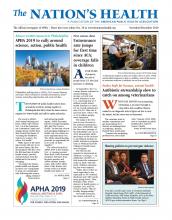After years of progress, the rate of people in the U.S. who lack insurance is climbing.
In September, the U.S. Census Bureau released its annual findings on income, poverty and health insurance in the U.S., reporting that 27.5 million people lacked health insurance in 2018, for an overall uninsurance rate of 8.5%. That rate is up from 2017, when 7.9%, or 25.6 million people, were uninsured.
The jump is the first year-to-year increase in the national uninsurance rate since 2008-2009, and the first since passage of the Affordable Care Act in 2010. Researchers attributed much of the increase to enrollment declines in public insurance programs such as Medicaid and the Children’s Health Insurance Program.
The bureau also reported a turnaround in children’s coverage — an additional 425,000 U.S. kids joined the uninsured ranks in 2018, with Hispanic children experiencing the worst impacts.
“Sadly, this is what we were expecting to see, especially as we watched Medicaid and CHIP enrollment going down,” Eliot Fishman, PhD, senior director of health policy at Families USA, told The Nation’s Health. “But it’s terribly disappointing.”
On health insurance, the census reported an overall decline of 0.4 percentage points in people with public coverage between 2017 and 2018. Medicaid coverage decreased by 0.7 percentage points, while the rate of Medicare coverage went up by 0.4 percentage points. In general, public health insurance covered about 34% of the country, while private coverage continued to be the most prevalent form of health insurance. Within private coverage, employer-sponsored insurance was the most common, covering just more than 55% of the population, though the rate of employer-based coverage did not change between 2017 and 2018.
While the census does not report on underlying contributors to coverage declines, advocates point to recent changes in Affordable Care Act rules and funding as likely reasons. Fishman, for example, said repeal of the ACA’s individual mandate, which required people to buy insurance or pay a fine, was a contributor to declining coverage, as was federal funding cuts to ACA navigator assistance and outreach marketing. The Trump administration’s decision to stop paying cost-sharing subsidies is likely also a factor.
“Undoing these harmful policies may involve political change,” he said. “What I would hope is that we can get to a point where there is a collective and bipartisan understanding that what we all want is for every American to have health insurance.”
Not all communities were impacted the same by declining insurance numbers. According to the Census Bureau report, among adults younger than 65, people ages 19 to 25 were most likely to go without health coverage, with an uninsured rate of more than 14%.
People with higher levels of educational attainment and higher household incomes were more likely to have health coverage than their peers with high school educations and those living in low-income households. As of 2018, more than 94% of whites had health coverage, compared to 93% of Asians, about 90% of blacks and just over 82% of Hispanics.
Uninsurance rates varied across states too, from a low of 2.8% in Massachusetts to a high of 17.7% in Texas. Six states and Washington, D.C., had uninsured rates of less than 5%, while six states had uninsured rates of 12% or more.
“The last couple years have seen huge drops in public coverage without the addition of coverage in the private sector, so we were very worried that this is exactly what would happen.”
— Bruce Lesley
Anne Dunkelberg, MPAff, associate director at the Center for Public Policy Priorities in Austin, Texas, noted that the ACA has been particularly beneficial for Texas, which had previously gone decades without a single-percentage-point improvement in its uninsured numbers.
Texas had experienced a steady decline in uninsurance rates following ACA implementation. And even with the recent coverage losses, Dunkelberg said Texas still has 750,000 fewer uninsured people than in did in 2013. She said the biggest barrier to continued progress is the state’s rejection of Medicaid expansion, which researchers estimate could expand coverage to almost 1.5 million more Texans.
“Leadership is a critical factor here,” she said. “We need a change of thinking by the folks in charge.”
Insurance coverage among children falls
Overall coverage for U.S. children fell in 2018, declining by 0.6 percentage points, the census reported. Uninsurance rates rose by one percentage point for Hispanic children, 0.5 percentage points for white children and stayed the same for children in other racial groups.
Children in the U.S. South were more likely to be uninsured than children in the rest of the country, with an uninsurance rate that increased 1.2 percentage points from 2017 to 2018.
Bruce Lesley, president of First Focus on Children, said the rise in kids without health coverage represents a reversal of decades of progress — since the 1997 passage of CHIP — that had driven the child uninsurance rate to historic lows. But like Fishman, Lesley was expecting the bad news.
“We’re sad to say this wasn’t a surprise,” Lesley told The Nation’s Health. “The last couple years have seen huge drops in public coverage without the addition of coverage in the private sector, so we were very worried that this is exactly what would happen.”
He also pointed to recent ACA changes for driving down kids’ coverage, as well as growing bureaucratic hurdles to enrolling in Medicaid in a number of states. Lesley also singled out the Trump administration’s immigration rhetoric and its so-called “public charge” rule — which makes it more difficult for immigrant families who have used public programs such as Medicaid to obtain green cards — for having a ”chilling effect” on children’s insurance enrollment. The census found Hispanic children experienced the greatest declines in coverage.
“This is the first big downturn (in children’s coverage) since CHIP came on the scene — in fact, we were still making progress even during the last recession,” said Lesley, an APHA member. “This drop is unprecedented in the last two decades.”
New data on poverty, income, inequality
The September census report also shared new numbers on income and poverty in the U.S.
According to the bureau, median household income in 2018 was $63,179, which was not statistically different than 2017. The 2018 real median income of U.S. Asian households increased 4.6% between 2017 and 2018, while 2018 real median incomes for white, black and Hispanic households were not statistically different from 2017.
On poverty, the country’s overall rate in 2018 was 11.8%, down 0.5 percentage points from 2017, marking the first time in 11 years that the poverty rate dipped significantly below 2007 levels, the year before the Great Recession. The poverty rate for whites was about 8% in 2018, compared to nearly 21% among blacks, 17.6% among Hispanics and about 10% for Asians. U.S. income inequality worsened in 2018, increasing to the highest level in decades.
APHA member Elise Gould, PhD, MPAff, senior economist at the Economic Policy Institute, noted that after adjusting for inflation and changes in how income is measured, U.S. median household income is still just below 2000 levels. Unemployment may be low, she said, but it is not translating into faster income growth or greater shared prosperity.
“The recession was deep, and it’s taken a long time to come back from it,” Gould told The Nation’s Health. “The growing economy is translating somewhat into household income growth, but not enough to make up for the losses...At this point, we shouldn’t just be treading water.”
For more information on “Income, Poverty and Health Insurance Coverage in the United States: 2018,” as well as new state and local statistics from the American Community Survey, visit www.census.gov.
- Copyright The Nation’s Health, American Public Health Association









